Govinda’s Groceries is the Newest Store to Serve New Vrindaban Village
By Madhava Smullen
Govinda’s Groceries, recently opened next to Govinda’s Restaurant at the Palace Lodge and run by longtime residents Nityodita and his wife Radha Dasi, is the newest store to contribute to New Vrindaban’s growth as a village.
It joins four others, each with their own specialties: The Palace Gift Shop near the entrance to Prabhupada’s Palace is run by Krsna Bhava and Kripamaya and caters mainly to tourists.
The Temple Gift Shop, located inside the entrance to Radha Vrindabanchandra’s Temple and run by Vani and Rupanuga, serves mainly pilgrims.
The New Vrindaban Artisan Co-op, located along the side of the Palace Lodge and run by Jamuna Dasi, sells locally made gift items to tourists, pilgrims and locals.
And the thrift store Krishna’s Attic, located on the ground floor of the Palace Lodge and run by Ananta and Vilasini, sells donated clothes and household items.
Govinda’s Groceries, meanwhile, will serve as that age-old village staple, the general store.
“We look upon New Vrindaban as a small village,” says shopkeeper Nityodita Das. “And generally a village means you should be able to get everything within it. So the ideal vision is to have a store that caters to the basic needs of the residents.”
The idea is not new to New Vrindaban. Over the years there have been a string of general stores including ISKCON Groceries and Simply Wonderful, managed by Meghamala Dasi in the late 1970s and ‘80s, and Hanuman’s Healthfoods, run by Jamuna Dasi in in the 1990s and 2000s.
As well as providing groceries, snacks, herbal medicines and more, the general store was also a “nerve center” where residents picked up the latest news and found a sympathetic ear.
But when Jamuna’s store closed five years ago, there was a gap until ISKCON New Vrindaban president Jaya Krishna Das encouraged devotees to open shops on the ground floor of the Palace Lodge building, alongside Govinda’s Restaurant.
Govinda’s Groceries, marked by a window with frosted lettering advertising its wares, is a warm, welcoming space that customers can drop into through the restaurant via an attractive archway.
The result of a full makeover, it has mango-yellow walls, a ceramic tile wood-look floor, candle chandeliers, ornate shelving, and lots of natural light from its glass door and picture windows.
Open from 1pm to 6pm with a view to extend its hours soon, Govinda’s stock serves two distinct customer bases: pilgrims and resident devotees.
The pilgrims are attracted by its deity dioramas, gift items like bath soaps and jewelry, and especially its homemade New Vrindaban hot-sauce, maha-prasadam, and “Vrindavan” brand ghee, which is cooked and bottled in New Vrindaban.
For residents the stock is more practical. There are Indian spices, chapati flour, dosa mix, and organic couscous and millet. There are natural versions of quick-meal staples like canned beans, frozen vegetables and not-dogs, and breakfast items like cereal and almond milk.
There are also organic snacks like rice cakes, kettle chips and Natural Brews sodas. And there are prasadam items from devotee company Pure Bliss like granola, spicy nuts and health bars.
“Next we really want to develop a line of what I call fast prasadam,” Nityodita says. He’s most excited by this idea. “Homemade sandwiches, spring rolls, cheesecake and more — prasadam alternatives to temple fare.”
In September, once the tourist season is over, Nityodita plans to survey resident devotees so that he can supply them with more of what they want. He intends to add fresh bread to his shelves, and if there is the demand even a weekly organic vegetable co-op. The idea is that devotees will be able to fulfill their basic grocery shopping needs within the community.
Nityodita feels that Govinda’s Groceries and all the other stores at the Palace Lodge will help bring devotees together.
“Right now we’re all going outside the village to spend our money, which is kind of backwards to the purpose of living in a community,” he says. “Investing in local businesses brings us together to share resources. And, to me, that’s a nicer future.”
New Vrindaban Recipes: A Village Built on Oat Water and Rice
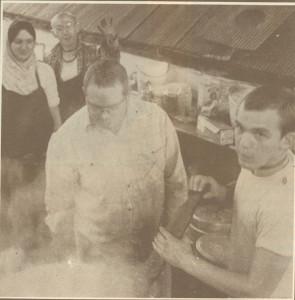
New Vrindaban Bahulaban Pits 1977 or 1978. From left to right: Sobhavati, Sankirtan, Bhokta & Advaita.
By: Madhava Smullen
Over the years, New Vrindaban has been famous for a long list of mouthwatering prasadam dishes – Hladini’s cinnamon rolls; Radhanath Swami’s sandesh; Madri, Dharmakala and Kutila’s cheesecake; Dharmakala’s baked goods and milk sweets; Taru and Amburish’s sweet rice; Vani’s dokla and idli, and many more.
But first, no story about New Vrindaban cuisine is complete without mentioning the legendary rice and oat water breakfast introduced in early 1976 and prepared by Sankirtan Das from 1977 until 1992.
It all began when Madhava Gosh read an article about how oat water was fed to inmates because of its energy-giving properties, and suggested it be adopted at New Vrindaban. Sudhanu Das then developed the first recipe and passed it on to fellow cook Tejomaya, who taught Sankirtan.
Oat water fueled the devotees who built New Vrindaban, and was symbolic of the austerities practiced in those early days. But, although an acquired taste, it could also be rather relishable.
“Oat water was not thick like oatmeal, but rather a savory liquid oatmeal brew,” says Sankirtan, who moved to New Vrindaban with his wife Ruci and their children on Gaura Purnima 1976. “I made it for 60 or 70 devotees, using 10 gallons of water, one gallon of oats, a cup of salt and ginger and raisins to taste.”
Sankirtan was one of those who relished oat water. “It was fantastic,” he says. “It was like having your morning cup of coffee before you got on the road. Sometimes it was sipped, and sometimes poured over the plain rice that went with it. In winter time, served hot, it warmed your insides and was a source of immediate heat against the cold.”
Just as the oat water symbolized the hardships of New Vrindaban life, it was also a challenge to cook.
From 1977 to 1979, Sankirtan prepared the rice and oat water breakfast in an outside kitchen in Bahulaban called “the pits,” which was just about as delightful as it sounds. Adjacent to the Deity kitchen, it had only a tin roof to protect one from the elements.
“I would collect my firewood the night before, because if it was wet, it would just smoke and wouldn’t ignite a decent fire to cook with,” he says. “I’d also fill the pot up with water at night.”

New Vrindaban Bahulaban pits 1977 or 1978. From left to right: Sobhavati, Bhokta, Advaita, Sankirtan, Kutila & Kuladri.
The next morning, Sankirtan would begin cooking at 5:00am, as in those days, devotees chanted most of their japa before mangala arati, had no japa period, and were finished the entire temple morning program and ready for breakfast by 7:00am.
The pits were literally three holes in the ground containing wood fires, with a grating over them on which the pots sat. Cooking over them was tricky.
“It was like a juggling act,” says Sankirtan. “You had to maintain a wood fire that would fluctuate if you weren’t attentive, while stirring the pot constantly so as not to burn anything. For the first few weeks until I got the hang of it, the rice was either uncooked, burnt, or mushy.”
The oat water was also a very precise recipe that could be easily ruined in a myriad of ways. At times over the years when Sankirtan was away for a few weeks, New Vrindaban residents would pray for him to return while his substitute undercooked it, oversalted it, or tossed in experimental ingredients to disastrous effect.
When each dish was done, Sankirtan struggled to lift the huge 20 gallon pots they were cooked in off the pits on his own, so that they wouldn’t burn. This left his apron covered in charcoal so black and all-encompassing that a visitor once mistook him for the mechanic.
The weather didn’t help, either.
“In the winter, it was an ordeal by both fire and ice,” Sankirtan says. “You were scorched on the side closest to the pits, but freezing cold on your back. And of course, if it rained or snowed you would be dealing with wet wood which didn’t give off too much heat but a lot of smoke.”
Sankirtan also cooked lunch six days a week, until the early 1980s. Fortunately, he had help with cutting vegetables and cleaning up from Shobavati Dasi. And in 1979, an indoor kitchen was built on the ground floor of the guest house in Bahulaban, making the cooking less challenging.
It was still hard work, however, and from 1981, what really kept Sankirtan going was pairing with fellow theater performer Lokamangala Das. Sankirtan would cook breakfast on his own, lunch with Lokamangala, and in the afternoon the two would work on developing plays.
“Sometimes we’d even rehearse our lines while cooking,” says Sankirtan. “It was kind of fun!”
Although he stopped cooking lunch when the devotee kitchen moved to the current temple complex in 1983, Sankirtan continued to cook breakfast until 1992. Both meals were plain – lunch was rice, dahl, chapatis, and later one subji too; what’s more, after lunch there was nothing to hold residents over until the next day but some leftovers.
Of course there were treats, too. On Sunday mornings, Jaya Murari would make a pancake breakfast with fresh homemade syrup. And Sunday Feasts would be a sumptuous spread, with New Vrindaban’s best cooks going all out, and families stashing the goodies for during the week.
But on an average week day, it was the oat water that woke the devotees up in the morning, and gave them the energy to go out and work hard to build Srila Prabhupada’s Palace, Sri Sri Radha Vrindabanchandra’s temple, the Palace Lodge, the residential cabins, vegetable and flower gardens, cow barns and everything else we think of as ISKCON New Vrindaban today.
“In the early days , devotees were performing austerities on a lot of different levels – the oat water was part of them,” says Sankirtan. “And personally I think that’s what built New Vrindaban. Everyone was performing the same austerities; we were all in it together. And that’s why, in one sense, there is a kind of comraderie between the older devotees here.”
Of his part, Sankirtan says, “I wasn’t a cook by nature. But I relished cooking because it was both a form of surrender for me, and a service to the devotees. And in that, I felt that I was helping to build New Vrindaban.”
We’ve modified the recipes for rice and oat water for home cooking and shared them with you below. Try them out and let us know how they inspire you with a flavor of that classic “Brijabasi Spirit!”
Rice (Serves 2)
Ingredients:
2 cups of water
1 cup of rice
1 teaspoon ghee (butter, or ghee impurities)
1/4 teaspoon of salt
(Approximate cooking time: 15 to 25 minutes)
1. Bring the water to boil in a sauce pan.
2. When the water boils, stir in the rice, salt, and ghee (if using), and bring it to a gentle simmer.
3. Cover the pot and turn the heat down low.
4. Start checking the rice around 15 minutes.
5. When done, the rice will be firm but tender, and no longer crunchy.
Oat Water (Serves 2)
Ingredients:
8 cups of water
1 cup of rolled oats
1 teaspoon ghee (butter, or ghee impurities)
1/4 teaspoon salt
Raisins & fresh ginger – to taste
(Approximate cooking time: 30 minutes)
1. Bring the water and salt to boil in a sauce pan.
2. When the water boils, stir in the oats, fresh ginger and ghee (if using) and bring it to a gentle simmer.
3. Stir occasionally and cook for approximately 30 minutes at a simmer.
4. The oat water is ready when the oats lose their form and become creamy.
5. Towards the end, add a few raisins so they get cooked enough to soften and plump up.
Thousands Expected For Another Blissful Janmastami at New Vrindaban
By Madhava Smullen
This year’s Janmastami festival at New Vrindaban, West Virginia on September 5th is expected to be packed with inspiring spiritual activities and sweet exchanges between residents and guests alike.
“Under the steady leadership of our community president Jaya Krishna Prabhu, the quality of the festival has been improving every year,” says one of the festival’s organizers Gaura Nataraj Das.
Around three thousand people, including ISKCON devotees from around the country, members of the Hindu community and some Western tourists are expected to attend. Meanwhile, the event will also be broadcast live internationally at Mayapur.tv.
The numbers demonstrate New Vrindaban’s popularity as a holy place where people can celebrate Lord Krishna’s appearance day on the United States’ East Coast.
After all, it was often described by Srila Prabhupada as non-different from Vrindavana, India. And with its beautiful Radha-Vrindabanchandra temple, cow protection program, and replicas of Govardhana Hill and Braja’s sacred lakes, it’s a place where one can truly celebrate Janmastami steeped in the mood of Krishna’s sacred village.
This year’s festival will begin with a stunning reveal of the altar at 8:00am that will send participants even deeper into this meditation. Dressed in a gorgeous new maroon and gold outfit imported from Vrindavana Dhama itself, Sri Sri Radha Vrindabanchandra will be nestled in a stunningly elaborate arrangement of flowers and foliage replicating the forest of Vrindavana.
Long-time community resident Varshana Swami will then immerse listeners in his trademark sweet stories of Krishna’s pastimes and deep philosophical realizations.
After more kirtans and spiritual discussion throughout the morning, there will be a sudarshan maha yajna fire ceremony for the auspiciousness of all at 3:00pm.
“Just as Lord Krishna’s sudarshana discus cuts everything, we’ll pray to the Lord to please cut away all the obstacles in our spiritual lives,” says Gaura Nataraj.
Next, everyone will make their way to the goshala, or cow barn, which will be beautifully decorated with flowers and festoons.
“Everyone will get the chance to worship Lord Krishna’s cows, whose horns and bodies will also be decorated for the occasion,” says Gaura Nataraj. “Then everyone will also get to pass below the stomach of the cow, which is considered very auspicious. It will be lots of fun!”
After that, it’s a special treat for the kids, with professional storyteller Sankirtan Das donning a ceremonial princely garb and telling the story of Krishna’s birth in his riveting style. Props, such as the basket in which Vasudeva carried the Lord across the Yamuna, will add to the experience.
After a stomping 7:00pm kirtan and Nrsimha arati, devotees and guests will get the chance to bathe the Lord, a sweet and intimate service.
“As we meditate on all the the fruit juices, milk, honey, and yoghurt cleaning the body of the Lord, our hearts will be cleansed,” says Gaura Nataraj. “It’s a highlight for many.”
Next, hundreds of dishes lovingly prepared at home and brought in by community members – subjis, rices, fried treats, chutneys, cakes, sweets, fruit, pies – will be piled onto the altar and offered to Lord Krishna.
Meanwhile, New Vrindaban residents will perform a drama telling the story of Krishna’s birth, Gujarati dancer Reshma Bharti will perform a traditional Bharat Natyam piece, and the children of Gopal’s Garden preschool will make a special appearance all dressed up as Radha, Krishna and the gopis of Vrindavana.
Throughout all these activities, of course, the momentum will be building towards the grand finale: the epic Janmastami midnight arati. As the rest of the temple room is plunged into darkness, the curtains will open to reveal a glowing altar, completely covered in a lavish bounty of green branches and flowers of every kind and color imaginable.
“In the morning, the pujaris decorate as much as they can with the one-and-a-half hours they have,” Gaura Nataraj says. “But after that, community residents pack into the prasadam hall to make flower arrangements all day, and the pujaris keep adding more and more to the altar. This year, our head pujari Abhinanda Prabhu is making a concerted effort to use up all our locally-grown New Vrindaban flowers. It will look like Radha Krishna are hiding in a beautiful grove of Vrindavana. People will be awestruck.”
As devotees and guests gaze on in amazement, the moving evening melody of “Samsara Dhava” will wash over them, gradually building into the most ecstatic kirtan of the day.
“Last year, men, women, children, young, old, all were dancing so enthusiastically,” says Gaura Nataraj. “My own daughter was only one-and-a-half years old at the time, and she was jumping too. People wait the whole day, participate in all the activities, and when the time comes to really express their love for Krishna by chanting His name and dancing, everyone does so with so much love and affection and great relish. The devotees love to express themselves!”
Gaura Nataraj is so carried away by the memory of this experience, that he forgets to mention the feast.
“Oh, yes, then at 1:30am, after fasting all day, we’ll have an Ekadasi feast for all our devotees and guests,” he says. It will be huge. There will be kichari, halava, pakoras, two or three types of subjis, soups, sweets, cakes, everything!”
For those who aren’t able to attend the Janmastami day festivities, another Janmastami festival will be held two weeks prior, on Saturday August 22nd. The celebrations will be mostly the same, with the midnight arati replaced by a 10:00pm Swan Boat festival in which small Deities of Radha Vrindabanchandra will ride across the waters of New Vrindaban’s Kusum Sarovara.
All in all, Janmastami 2015 at New Vrindaban is expected to have a profound impact on the thousands that participate in it.
“This festival nourishes relationships between residents and guests, and its sheer beauty and grandeur deepens their faith and inspires them to become more serious in their spiritual practices,” Gaura Nataraja says.
Tri-state Area Invited to Celebrate Ancient Indian Chariot Festival in Moundsville
By Madhava Smullen
After Festival of Colors (Holi) drew 5,000 people last September, tri-state area locals are invited to come and participate in another one of India’s most ancient and popular celebrations, Festival of Chariots (Ratha-Yatra), in Moundsville on Saturday July 18th.
In the holy city of Puri in Orissa, India where it originated, the annual procession – full of music and dance — draws over one million pilgrims. Each hopes to get the honor of pulling the ropes of the 45-foot-high chariots carrying the deity of Jagannath (Lord of the Universe, a name for God) and His companions, Baladeva and Subhadra.
For the British ruling India in the 1800s, the festival was such a powerful experience and the sight of Lord Jagannath on His chariot so awe-inspiring that it originated the word “juggernaut.”
The historic festival was first transplanted to the Western World by the Hare Krishna Movement in San Francsisco in 1967. Today, it’s held every summer in over 200 cities worldwide.
The Hare Krishna temple in the unincorporated village of New Vrindaban, near Moundsville, has been celebrating its own Festival of Chariots since 1973. But this one, its 42nd, is the first time locals have been invited to participate on a large scale.
Between 800 and 1,000 people are anticipated for the event, with locals from the tri-state area expected to join Hare Krishna devotees from along the East Coast.
The day will begin with the usual early morning worship at New Vrindaban’s Krishna temple, followed by a talk at 8:00am explaining the history and significance of the Festival of Chariots.
“For all faiths, although we understand God is everywhere, we go to the temple, church, synagogue or mosque to see Him,” says Malati Devi, who helped organize the first Festival of Chariots outside India in 1967. “But not everyone goes to those places. So Jagannath comes out of his temple on Ratha Yatra so that everyone can see him, smiling from His chariot.”
Everyone will be able to see Jagannath’s broad smile – His defining characteristic – when the parade starts at 11:30am on McCreary’s Ridge Road.
The over five-foot tall deity will look out from a hand-carved chariot with a vibrant red and yellow canopy topped with a gold spire that will rise 30 feet into the air.
The colorful parade, filled with balloons, flags, joyous Mantra music and dancing, will last around two hours and cover just over a mile.
It will pass the Palace of Gold – dubbed one of the eight religious wonders in the U.S. by CNN – as well as a recreation of India’s sacred Kusum Sarovara lake and giant figures of 15th century Bengali saints on its way to the Hare Krishna temple.
At the temple, a sumptuous Indian vegetarian feast will be served from 2:00 to 3:30pm free of charge, featuring rice, vegetable curry, vegetable frittes, and mango yoghurt drink. For dessert, there’ll be rice pudding, and gulabjamun, a spongy milk powder sweet soaked in rosewater syrup that has to be tasted to be believed.
At 4:00pm, visitors will get the chance to push smaller deities of Jagannath, Baladeva and Subhadra on an ornate swing in a ceremony called “Jhulan Yatra.” This will be followed by a play portraying the Festival of Chariot’s history, and a traditional arati worship ceremony in the main temple space.
“Meanwhile, we’ll be offering continuous temple tours from 3:00 to 7:00pm,” says director of public relations Vrindavan Das. “It’s a wonderful opportunity to learn about this ancient culture and interact with practioners from different parts of North America.”
The day will end in grand style with the “Swan Boat Festival” from 9:30 to around 10:15pm. Tiki torches will cast an echanting glow in the darkness as small deities of Jagannath, Baladeva and Subhadra ride on a swan-shaped boat across the mirror-like waters of Kusum Lake. There’ll be more mantra music and dancing, culminating with a firework display in the night sky.
The saying, ‘And a good time was had by all’ fits the Festival of Chariots perfectly,” says Malati. “It’s just a great family day out with a wonderful, congenial atmosphere.”
Just-Installed New Vrindaban Playground “An Investment In Our Families”
By Madhava Smullen
On Monday June 29th, New Vrindaban children waited excitedly while an inaugural puja was offered to open their brand new fully-equipped playground next to the Palace Lodge, before running into it to play with blissful abandon.
The playground is an endeavor by ISKCON New Vrindaban to serve and accommodate both the children who live in the village and the thousands who visit for festivals throughout the year with their families.
Ananga Manjari Dasi, mother to five-year old Chintamani and a member of the ISKCON New Vrindaban Board since early this year, brought the suggestion to the board when she saw the dilapidated condition of the old playground.
“It had been there for over twenty years, since the early 1990s,” she says. “It was a wooden play set, and carpenter bees had bored into the wood until it looked like Swiss cheese. The metal parts were all rusty. It was rickety and falling apart. And it didn’t have proper drainage, so there would often be standing water and it would get muddy. As a parent, I was concerned for my kids’ safety.”
While participating in the Farmers’ Market in Wheeling, Ananga Manjari would regularly see the stellar children’s facilities at other local churches. And with ISKCON New Vrindaban repairing a lot of its long-neglected infrastructure, she wanted to do something for the children too.
“As a new board member, I want to bring something to the table that shows that we put our kids first,” she says.
The ISKCON New Vrindaban Board agreed unanimously to fund the project. So Ananga Manjari partnered with Malati Dasi, whose previous research on play sets led them to a Mennonite family-run business in the Pennsylvanian countryside.
“My daughter Chintamani played with everything, and we asked her what she liked,” says Ananga. “We also customized our purchase according to our community’s needs. For example, they had play sets with closed-in playhouses and tube slides. But we didn’t get them because we wanted to make sure that parents never lost sight of their kids on the playground. We wanted everything to be visible and open.”
Back at New Vrindaban, facilities manager Gopisa Das oversaw the installation of new French drains at the playground site to eliminate the previous problems with mud and standing water. Over these, gravel was laid, and then several inches of shredded recyclable rubber mulch, which is shock absorbent and doesn’t rot.
Meanwhile the playground itself was installed by the Mennonite family who handmade it. “It felt really good to support not only local business, but also God-loving, gentle people from another religious community,” says Ananga.
The new playground includes a rock climbing wall with a rope, two standard swings, two baby swings, a tire swing, trapeze bars, a slide, and a bridge that connects two towers. It also includes items donated by Malati – a seesaw, and three benches so that parents can sit comfortably right in the playground to watch their children.
“We’re trying to cultivate a culture of parents and caregivers staying with their children at all times,” says Ananga Manjari.
All pieces of the play set are made of wood that is vinyl-coated to keep out carpenter bees and eliminate the possibility of splinters. Safety is also ensured by the railings throughout and the eighteen-inch faux rock wall surrounding the playground. Looking down over the whole scene is a picture of Lord Nrsimhadeva, who fiercely protected His five-year-old devotee Prahlad, and lovingly watches over all His devotees.
Ananga Manjari smiles, remembering how, during her most recent visit to the temple, she saw kids of all ages having a great time on the new playground.
“I see this as an investment in our families,” she says. “And I see it as just the beginning of making New Vrindaban so family-friendly that families will want to come here and stay – not just for one or two years, but for good, because it’s such a great place to raise children.”
An Eternal Relationship: Prabhupada’s Fourth Visit to New Vrindaban
Written by Madhava Smullen. Archival Research by Chaitanya Mangala.
June 21st, 1976 was a normal day at the Pittsburgh International airport until a group of Krishna devotees from New Vrindaban, dressed in an odd combination of dhotis or saris with large rubber farm boots, appeared. Commuters stared open-mouthed as the fifty-strong crew exploded into a cacophonous burst of chanting, mridanga drums, and gongs in front of the arrival gate.
They were there, of course, to greet their beloved guru Srila Prabhupada, who appeared presently, effulgent and regal with his silver-topped cane and bright orange sweater. Diving to the floor to offer their respects, the devotees piled flower garlands about his neck and fanned him vigorously with peacock feathers.
Some ninety minutes later, Prabhupada’s car entered the New Vrindaban community limits. He was deeply attached to his first farm project — in late 1975, he had written to disciples: “I am always praying to Krishna that the New Vrindaban attempt will be more and more successful and ideal for your country. That is my only prayer.”
Now, he could see progress being made. The devotees riding with him pointed out new buildings, including one under construction next to the existing temple that would house workshops and a large capacity hall for festivals. There was also a new barn, and a silo for grain storage. Prabhupada smiled. “Oh, much improvement,” he said.
As he entered Sri Sri Radha-Vrindabanchandra’s temple at Bahulaban, Prabhupada was welcomed by over a hundred devotees, many of them families with children. After folding his hands before the Deities, he led a lively kirtan from his vyasasana. As it ended, he looked fondly over his disciples.
“So after two years I think, I have got the opportunity of seeing you and your Radha-Vrindabanchandra Who is so kind upon you,” he said. “So real happiness is here. Radha-Vrindabanchandra is staying here, and He’s pleased with your service. This is the perfection of life.”
Then, as kirtan rang out once more, he departed for the house of Vahna Das and Hladini Dasi in Madhuban, where he would reside throughout his eleven-day stay until July 2nd.
Prabhupada’s health proved troublesome during his visit — he suffered from heart palpitations and often had to miss morning walks. But his leadership was as strong as ever, as he emphasized the five primary things he wanted New Vrindaban to be known for: cow protection, simple-living, holy pilgrimage, spiritual education, and above all, loving Krishna.
To highlight the importance of cow protection during his stay, Prabhupada visited the cows and calves at the Bahulaban barn, which had been completed a year earlier. Four new calves had just been born, and he let one lick his hand as devotees told him how they were turning the cows’ milk into ghee, cheese and buttermilk. Prabhupada enjoyed the visit, and gave his solution for a better life: “Simply expand this idea: krsi-go-raksya-vanijyam [protect the cows].”
Prabhupada’s care for cows wasn’t just theoretical. Once during his stay, he was walking with disciples when he passed a herd grazing on a hill. Among them was New Vrindaban’s first cow, a black Jersey named Kaliya whom he had met back in May 1969. To the devotees’ amazement, she broke away from the other cows as soon as she saw him and made her way down the steep bank to him. “Ah,” Prabhupada said. “My dear old friend Kaliya.”
Close to cow protection, of course, is simple living. Prabhupada often extolled the virtues of New Vrindaban’s simple living and high thinking in contrast to all the endeavor modern man puts into gaining sense gratification, thus forgetting the real purpose of life. He visited the community’s different gardens, appreciated how Sri Sri Radha-Vrindabanchandra were bedecked with fresh wild flowers, and was delighted to receive wildflower garlands himself.
While taking his morning walk with disciples in the “forest” of Talaban, Prabhupada encouraged devotees to buy as many of the neighboring parcels of land as possible to cultivate. And he appreciated when they showed him that they were growing their own hay for the cows, cutting their own lumber, and growing some of their own vegetables.
Prabhupada further encouraged devotees by enjoying “The Spiritual Frontier,” a film about New Vrindaban, so much that he watched it twice. Produced by Yadubara and Visakha, it was vividly colorful and beautifully shot. It showed the “Brijabasis” living a Krishna conscious life while harvesting crops, picking fruit from the trees, and preparing natural milk products.
Energized by the film, Prabhupada used it as an opportunity to talk more about simple living. “Make this ideal life here,’ he said. “America has got good potency. We have got so much land here. We can have hundreds of New Vrindabans or farms like that. And people will be happy. And invite all the world, ‘Please come and live with us. Why you are suffering congestion, overpopulation? Welcome here. Chant Hare Krsna.’ Make that.”
It was clear that Srila Prabhupada wanted others to visit New Vrindaban as a holy pilgrimage site, and he treated it as such himself. During his stay he visited not only the main Deities of Radha Vrindabanchandra in their temple, but also the other Deities worshipped in different parts of the community, just as one would during a pilgrimage of the original Vrindavana in India.
He was most eager to see Sri Sri Radha Vrindaban Nath, the Deities at the original farmhouse where he had stayed during his first visit in 1969. The farmhouse was now a brahmachari ashram, and when they heard Prabhupada was coming, the men there burst into a frenzy of activity, trying their best to clean it up for him. As he walked up to the house, the atmosphere was electric, with many devotees including gurukula children lining the pathway to greet him.
Prabhupada was happy to be back. With folded hands, he took darshan of the small but beautiful Radha Vrindaban Nath while the Govindam prayers played, then gave the morning Bhagavatam class from a rustic-looking vyasasana.
He also visited the site of a future place of pilgrimage – the Palace his disciples were building for him. It was his second visit (his first had been in 1974), and now most of the concrete work was done, and the finishing work started.
The devotees showed him the central hall, Deity room, beautiful marble inlay work, decorative arches and ornate furniture. He particularly liked his hand-carved desk topped with a solid slab of onyx, commenting, “Nowhere else in the world do I have such a desk.”
He was very appreciative and impressed that the devotees had done all the work themselves, especially since most were not professionals but had learned on the job. Prabhupada remarked that they were working with the special inspiration of God.
“If one is sincere to serve the Lord, [who is] situated in everyone’s heart, He’ll give him, ‘Do like this,’” he said. To the devotees’ delight, he compared their efforts to his own. “I came to your country for preaching this, I had no idea how to do it.” He laughed. “But people are surprised how within so many short years this world movement has sprung.”
Prabhupada added that the Palace, a combination of Eastern and Western architectural ideas, was unique in North America and that people would therefore come from all over to see it.
Another thing Prabhupada focused on while in New Vrindaban, as he did everywhere, was imparting spiritual education to his young students. He did it all the time, whether he was giving the morning Bhagavatam class or receiving a massage outside in the noonday sun. His disciples’ most cherished times with him, however, were his intimate evening darshans in the garden at the back of his house, during which his congenial mood deepend their love and affection for him.
On those idyllic summer evenings, the devotees gathered in a semicircle on the grass before Prabhupada, the sun’s golden rays filtering through the trees and casting a dappled pattern on his yellow satin vyasasana with its lion armrests.
Prabhupada would be reluctant to take his own seat until he saw that all the devotees also had mats to sit on. Once he did, he would instigate debate on challenging issues, with them taking on the role of materialists and Prabhupada arguing from the Krishna conscious point of view.
At other times, he had Sanskrit scholar Pradyumna read from the Bhagavad-gita, stopping occasionally to ask if there were any questions and then supplying his insights. One topic that often came up was how modern developments had spoiled the world. “What is this nonsense, all skyscraper building, no air, no light,” Prabhupada said. “The mind becomes crippled, the health becomes deteriorated, children cannot see even the sky, everything is spoiled.”

Prabhupada’s Evening Darshan With Devotees On Yellow Satin Vyasasan at Madhuban Farm – New Vrindaban 1976
Then, looking around at the beautiful garden he was sitting in, he cited New Vrindaban as an alternative. “Now we see the sky, the sun, how nice it is. Green, down and up, clear sky, sun. This is life.”
Prabhupada also supported New Vrindaban’s own efforts at spiritual education by visiting its gurukula. There he received guru-puja in a packed temple room, with the young saffron-clad boys crowding in front of him. It was another incredibly sweet experience, with Prabhupada playing his gong and throwing flowers over the devotees as they jumped and shouted excitedly.
Throughout his entire visit, Prabhupada showed his disciples how to love Krishna – the connecting thread of his five-part vision for New Vrindaban — by everything he did and said.
It was in the way he looked at and spoke about Radha Vrindabanchandra, completely convinced that full happiness would come through serving Them. It was in the way he cared for Krishna’s devotees, making sure they were comfortable and warm during his evening meetings. And it was in the way he saw Krishna everywhere – once he compared young “Brijabasi” boys running alongside his car to Krishna and Balarama racing with the birds in the fields.
Love of Krishna was even the last message he gave New Vrindaban devotees face to face, imploring them during his final class on July 2nd to become servants of Krishna instead of servants of their senses. By doing that, he said, their lives would be successful.
After his class, the devotees held one last rousing kirtan. The little gurukula boys danced enthusiastically, then clamored about his vyasasana, shyly holding out their hands as Prabhupada passed out cookies to them.
That afternoon, everyone gathered outside the temple to bid farewell, presenting him with a cake and a donation. Then, as his car pulled out onto the road, they showered it with flowers, calling out “Jaya Srila Prabhupada!” at the top of their lungs as it faded away into the distance.
It would be the last time New Vrindaban devotees saw Prabhupada physically present in their community. But they had implicit faith he would be with them forever through his instructions, firmly imprinted in their hearts, as they continued working together cooperatively to realize his grand vision for ISKCON’s first farm community and holy place of pilgrimage.
ECO-Vrindaban Board Meeting Minutes 06/14/2015
ECO-Vrindaban Board Meeting Minutes 06/14/2015
Mission Statement: ECO-Vrindaban promotes Simple Living, Cow Protection, Engaging Oxen, Local Agriculture, and above all, Loving Krishna, as envisioned by Srila Prabhupada, the Founder-Acharya of ISKCON New Vrindaban.
Participating Board Members: Anuttama, Bhima, Chaitanya Mangala, Kripamaya, Madhava Gosh (partial attendance), and Ranaka.
Participating Advisors: Sri Tulasi Manjari, Radha-Krishna
Participating Managers: Mukunda
Recording secretary: Jamuna Jivani
1. Manager’s Report
Mukunda gave a summary of the projects he has been overseeing his first month in his new role as an ECO-V co-manager:
– Training Oxen: Mukunda and the Ox-Training crew are presently studying various locations around the Bahulaban barn with the intent to prepare an area suitable for the next training phase of the oxen (learning to pull plowing implements for growing food).
– Teaching Garden: The shed is being repurposed as a storehouse for use over the next few months.
– Palace Rose Garden: With the help of Paul Zimmerman, an organic rose garden consultant, Mukunda is working with the Rose Garden crew to create a comprehensive month-by-month Rose Garden Care Manual.
– Prabhupada House: The final touches are being done to make it suitable for Mukunda and his family.
– Bahulaban Barn Renovation: Vyasasana prabhu is doing the work in between his other projects. The second floor wall on the road side has recently been restored, and new studs, sheathing, house wrap and insulated windows have been installed. The ECO-V Board requests that Vyasasan prabhu finish closing in the exterior of the barn by the end of September, 2015 (well ahead of the next winter season).
2. Ray’s Recovery
Ranaka reports that Ray is mostly recovered and has been back on the job part-time the past two weeks.
3. Palace Rose Garden Additional Funds Request
Jaya Krsna requested additional funding for another visit from Paul Zimmerman.
WHEREAS: The ECO-V Board wishes to support ISKCON New Vrindaban’s efforts in sustainable gardening.
RESOLVED: The Board authorizes an additional $2K for the Rose Garden project.
4. Eco-Village at New Vrindaban
Mukunda and Vraja-Dhama will be meeting weekly to research possible locations for a future eco-village site. Mukunda suggests that a hydrogeologist is needed to make a recommendation based on the possible locations.
5. Prabhupada’s Palace Renovation Matching Grant
Of the $425K allotted, $281K remains available. Some ECO-V Board Members have questions connected with the renovations and will ask them at the next joint board meeting.
Mukunda Das Begins Service as New ECO-Vrindaban Co-Manager
By Madhava Smullen
Mukunda Das — ECO-V’s brand new co-manager along with Ranaka Das — moved to New Vrindaban on May 17th from Alachua, Florida with his wife Bhakti-lata Dasi, and has enthusiastically started serving in the community.
Born Marc Gauthier in Montreal, Canada, he was always an outdoorsman and interested in the deeper questions in life. As a young man, he worked at seasonal jobs doing tree-planting and apple-picking in Western Canada. In his free time, he would hike the Canadian Rockies in Banff National Park and reflect on how to find an engagement that would truly bring him satisfaction.
Meanwhile he also practiced Hatha yoga and studied Eastern philosophy with the Theosophical Society, which led him to Sri Aurobindo’s Bhagavad-gita. Finding it hard to understand, he went to another Gita he had gotten in college — Srila Prabhupada’s Bhagavad-gita As It Is.
“I still couldn’t understand, but the one thing that grabbed my mind like a catchy song was the name at the bottom of the cover,” he says. “I started reciting it constantly: A.C. Bhaktivedanta Swami Prabhupada; A.C. BhaktivedantaSwami Prabhupada.”
Soon after, in 1984 at the age of 22, he met an old friend who had joined the Hare Krishna movement, and told him that it answered all the questions they had been asking in college. Marc spent a few days in the temple, and after experiencing the peace it gave him, decided to move in.
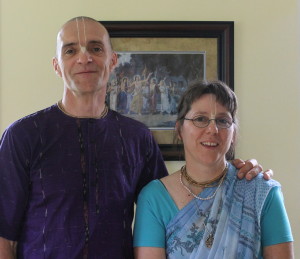
First, though, he had to tell his girlfriend Bernadette, whom he had met a year and a half before and instantly clicked with. Bracing himself, he told her, “I’m going to live with the Krishnas.” Immediately, she responded, “Well, if it’s good enough for you, it’s good enough for me.”
The couple became Mukunda Das and Bhakti-lata Dasi. Over the next five years, she served as Lord Jagannath’s pujari, he cooked at Govinda’s restaurant, and they both collected funds for the Montreal temple, among other services.
In 1989, they moved to a devotee community in Mississippi, where Mukunda became a construction worker. From there, they moved to Prabhupada Village, North Carolina, and in 2001 to Alachua, Florida, where they remained until moving to New Vrindaban this year.
While in North Carolina, Mukunda got his State Contractor’s license and started his own construction company. Working with a special energy efficient construction technique using insulated concrete forms, he has since built most of the houses in Prabhupada Village, constructed a secure vault to store all of Srila Prabhupada’s original manuscripts at the Bhaktivedanta Archives there, and built many residential homes and some commercial buildings.
Interestingly, in the late ‘90s he also helped construct the houses at Balabhadra Das’s cow protection program ISCOWP in New Vrindaban using the same technique.
Always looking for ways to broaden his skillset, discover his full potential, and help others, Mukunda also took many personal development, communication, and leadership courses over the years. He completed a certification in life coaching at the Coaches’ Training Institute (CTI) in San Rafael, California, one of the first and most prestigious life coaching schools in the U.S., and has coached several clients including devotees, PhDs, and a CEO.
“I followed that with the CTI’s ten-month intensive leadership training program, which was life-altering,” Mukunda says. “It gave me a lot of my perspective on the necessity for community development, and inspired me to try to realize Srila Prabhupada’s desire for self-sufficient communities, which I call devotional Eco-Villages.”
On this mission, Mukunda discovered the Fellowship for Intentional Communities (www.ic.org) and took several of their courses on community building and conflict resolution. He also took classes in natural building techniques such as cob, straw-bale, and traditional timber frame. And he visited several successful intentional communities including the Farm in Summertown, Tennessee and O.U.R. Eco-Village on Vancouver Island, British Columbia.
“During my visits, I took the permaculture design certificate training, and had conversations with the communities’ founders to find out what worked, what didn’t work, what made them successful, and what the challenges were,” he says.
So when Mukunda learned that ECO-V was looking for a co-manager, it seemed like an opportunity he had to find out more about. After submitting a questionnaire to then chairman Navina-Shyam Das, he was invited to New Vrindaban to meet with the joint boards.
When the mutual decision was made for Mukunda to come on-board as ECO-V’s co-manager, he made arrangements and moved to New Vrindaban on May 17th this year.
His wife Bhakti-lata Dasi has moved with him. She runs the U.S. ISKCON Prison Ministry – which corresponds with inmates all over the U.S. and sends them Srila Prabhupada’s books — and will be relocating it to New Vrindaban.
The rest of Mukunda’s family is remaining in Gainesville, Florida. His youngest daughter, Ulupi, 21, is working in retail and is in the process of finding her career path. His older daughter Manjari, 27, works as a massage therapist and birth doula. His son-in-law Madhava – Manjari’s husband and your reporter on this story – also works for ISKCON New Vrindaban remotely as its communication department’s staff writer. And his grand-daughter and Manjari and Madhava’s daughter, Ambika, 11 months, mostly points at things and shouts, “Ga!”
Mukunda will start out at ECO-V by helping or overseeing a number of construction projects. These include completing the renovation of “the Green House,” now known as the “the Prabhupada House,” where he and his wife are living temporarily; coordinating with Vyasasana who is finishing renovations on the exterior of the Bahulaban ox barn; and renovating an office space for himself and his future team next to Ranaka’s office at the Valley Barn.
As co-manager, Mukunda is also assisting Ranaka Das in his service. “A large percentage of my service could be called Human Resources, or HR,” he says. “I’m assisting and communicating with the devotees engaged in various ECO-V services such as the ox training program and soon the cow protection program. I’m trying to hear their needs and ideas, come up with ways to make their service easier, and improve their overall service environment. And I’m interviewing applicants for ECO-V’s new organic garden and ox training manager positions.”
There are more long term projects too. ECO-V plans to cooperate with ISKCON New Vrindaban to build a Food Processing facility right next to the Garden of Seven Gates, which will ready produce for the Deity, devotee and restaurant kitchens, and dehydrate or freeze-dry excess produce so it doesn’t go to waste. Mukunda will also participate in the long term development of a devotional eco-village within New Vrindaban.
“Although I miss my family in Florida so much, I am thrilled to be in devotee association, using my full set of skills and then some, and being stretched into all the talents that Krishna seems to have given me over the years,” he says. “And I feel very, very grateful to ECO-V for that opportunity.”
New Vrindaban Community Tour Reveals Renovated Deity Facilities and More
By Madhava Smullen
The community parikrama on the second morning of this spring’s ISKCON New Vrindaban and ECO-V Joint Board Meetings revealed a host of exciting renovations, showing that the efforts of recent years are beginning to bring a new sheen to a once crumbling infrastructure.
The March 15th tour began at 10:00am with a tangible sense of anticipation as residents and board members alike crowded into the hallway outside Sri Sri Radha-Vrindabanchandra’s Deity kitchen to the pounding of mridanga drums and chanting of the Hare Krishna mantra.
Offering a ghee lamp and breaking a ceremonial coconut in the doorway, head priest Abhinandana Das welcomed everyone to follow a path of brightly colored rice mandalas into the newly renovated kitchen.
Visitors were met with bright new white paint on the walls, gleaming stainless steel counters, sinks and stove, and an overall polished, professional and mode-of-goodness feel. Everywhere, ceremonial ribbons, fruit and vegetables created a celebratory, auspicious scene.
After community president Jaya Krishna Das offered arati to pictures of Sri-Sri Radha-Vrindabanchandra, Lord Nrsimhadava and a small murti of Srila Prabhupada, milksweet cook Dhara Dasi boiled the first pot of milk for the Lord in the new kitchen, and the devotees cheered.
Facilities manager Gopisa Das then explained how the walls had been cleaned, stripped and painted, broken tile removed from the floor, and the floor painted and refinished to lessen the danger of slipping. The ceiling had also been refinished, and new lighting, more spacious sinks and an expanded area for the Lord’s plates installed.
Gopisa added that more renovations were still to come later in the spring, including new pot racks, heavy rubber non-slip mats, and new flooring in the hallway.
The pujari room was the next stop, with Jaya Krishna and Gopisa pointing out the beautiful new wooden flooring, brand new granite countertops replacing the previous thirty-year-old ones, and walls repainted an attractive yellow. Broken cabinets had been replaced with nice new wooden ones, there were new lighting fixtures, and the ceiling – which used to be riddled with cracks that dirt would fall from – had been fixed.
“We are very happy about how it looks now,” said Jaya Krishna. “It’s a great improvement for their Lordships.”
Next the parikrama moved on to the truly stunning Deity dressing room. Five years ago, carpenter Vyasasana Das had installed new cupboards, granite countertops for dressing the small Deities, and a rich dark wood floor. Now, the ceiling had been redone, new lights added, and a huge wooden countertop installed in the center of the room for dressing the large Deities.
Because new Deity outfits are added every year, the cupboard space was still inadequate, however, and Jaya Krishna explained that an expansion would be added across the hall soon to solve the problem. In addition, a dedicated sewing room – an old mainstay of New Vrindaban – was being re-established.
“Radhanath Swami, an early resident of New Vrindaban, recalled that the community used to be famous for having the best outfit makers and jewelry makers,” Jaya Krishna said. “We want to go back to that.”
Sundari Dasi was behind the renovation of another spot, the temple library, which until now had been in such a dilapidated condition that devotees didn’t even want to set foot in it.
With new wood flooring, bright white repainted walls and ceiling, comfy new furniture, a trendy upstairs loft and wrought iron candle holders decorating the walls, it had been turned into a cosy reading retreat.
The library already carried Prabhupada’s books and conversations, works by other Vaishnava Acharyas and ISKCON authors, collections of Back to Godhead magazines, and encyclopedias and other reference books. Interfaith books, Jaya Krishna explained, would soon be added upstairs; special reading hours would be introduced, and there would be a system for devotees to borrow and return books. In the future, there would also be Internet access so that devotees could listen to classes through ISKCON Desire Tree and more.
“We’re very happy about doing something for brahminical culture,” said Jaya Krishna.
The tour next visited the renovated guest rooms in the temple building. These featured new wood flooring, white sheetrock walls, attractive ceiling lights, and bedside tables and lamps, along with two double beds with clean white pillows and comforters – a very different scene from what most people expect to find in an average ashram room.
“After falling behind at least thirty years in maintenance, there’s still a lot to do at New Vrindaban,” Jaya Krishna said. “For instance in the hallways, the dripping ceilings need to be fixed, the flooring replaced and more lights added. But we’ve made a good start.”
The tour next made its way outside, to visit the ox barn in Bahulaban, which had been deconstructed to just its core and then rebuilt. Since the previous Joint Board Meetings in November 2014, when it was little more than a frame, it had come a long way thanks to Vyasasana Dasa and crew.
The outside of the two-storey building now featured an attractive green and white siding, with a new wooden stairway and landing leading up to the still-under-constuction top floor. Inside, there were stalls and hay storage areas for the oxen to eat from, and a tack room where handmade cherrywood yokes were displayed. Meanwhile outside in the back was a cemented training area where trainer Richard was taking handsome young Hari and Priya through a set of commands. Two other pairs of oxen are also being trained to till the gardens and pull carts.
The final stop on the tour was the badly dilapidated utility building opposite the ox barn, which recently had its roof completely replaced. Plans were also underway, Gopisa explained, to gradually renovate the rest.
It was encouraging evidence for parikrama-goers, along with everything else they had seen during the tour, of a community being slowly yet steadily rebuilt.
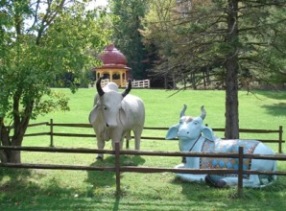
Welcome to Brijabasi Spirit
Thank you for taking the time to visit the New Vrindaban community blog. Think of visiting our blog as making a virtual pilgrimage.
Hare Krishna Hare KrishnaKrishna Krishna Hare Hare
Hare Rama Hare Rama
Rama Rama Hare Hare
"May cows stay in front of me; may cows stay behind me; may cows stay on both sides of me. May I always reside in the midst of cows."
Hari Bhakti-vilas 16.252











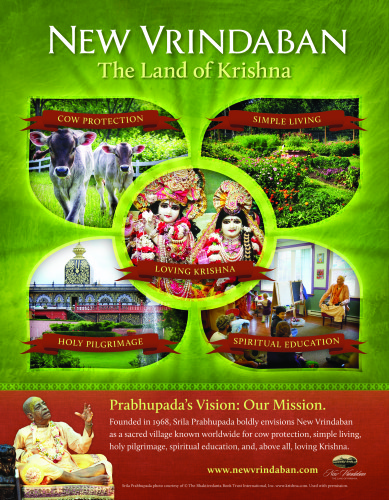

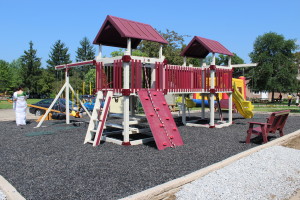
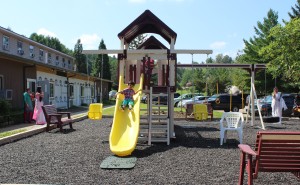
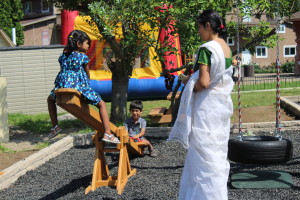




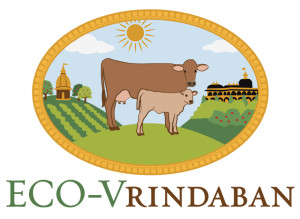
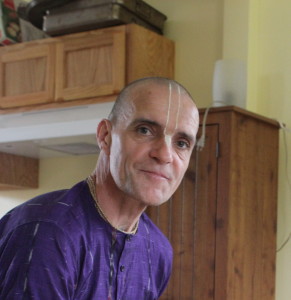
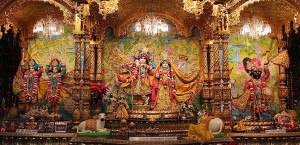
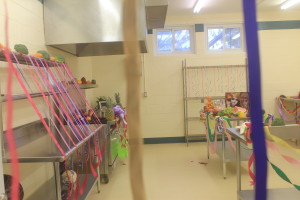
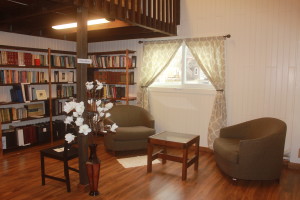
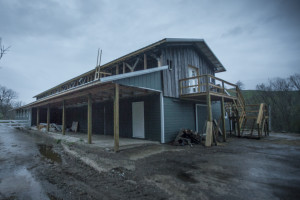
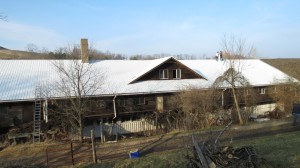




Recent Comments